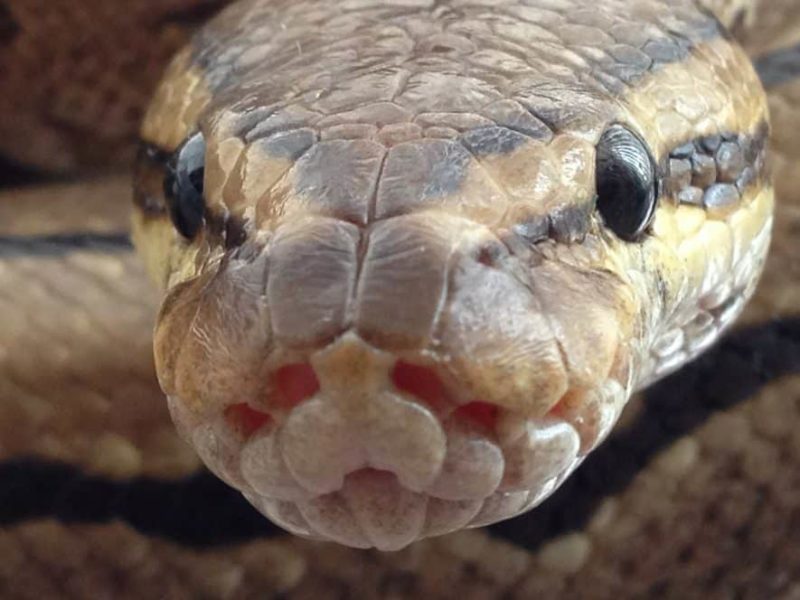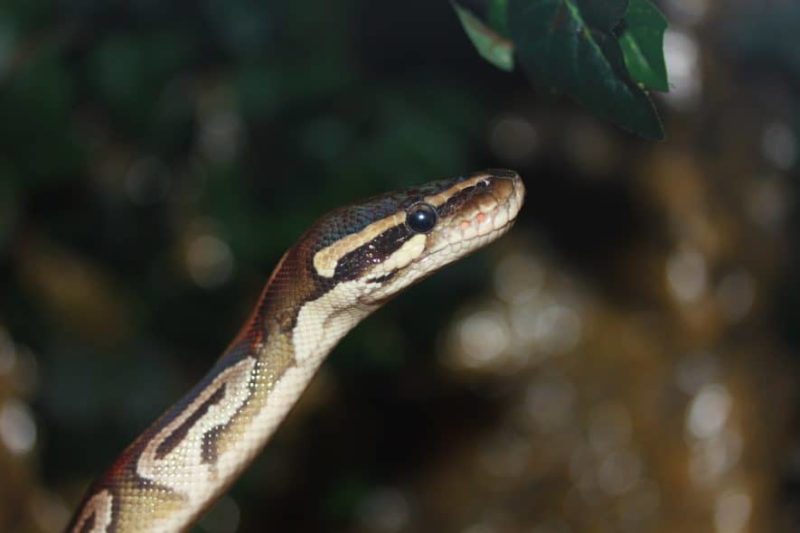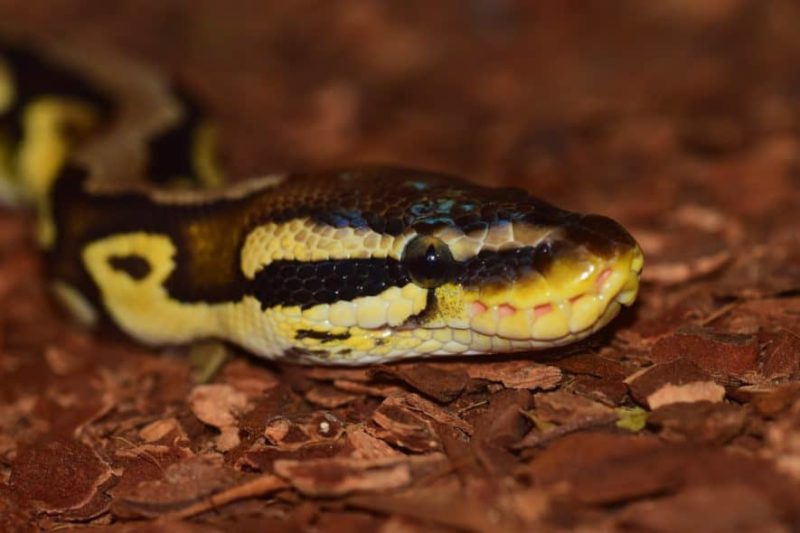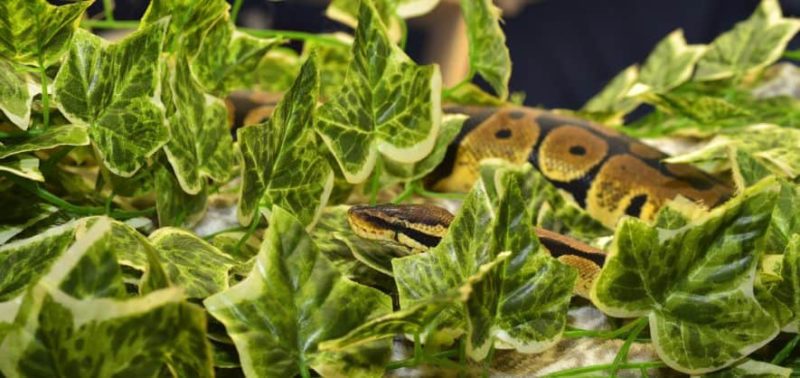When choosing a pet reptile you have to understand their health issues and typical behaviors. Some species can be challenging for beginners, so look for a pet that’s naturally hardy and easygoing – like the ball python (but only the captive-bred ones)
Early in my reptile-keeping journey, I worked with thousands of wild-caught ball pythons and almost all of them arrived with multiple health problems like tick infestations, respiratory infections, poor sheds, and infected wounds were very common in them.
But captive-bred ball pythons are a world apart. They are healthy, adaptable, and among the sweetest-natured snakes out there.
Honestly, what more could a first-time snake owner wish for?
Want to know more about the behaviors and illnesses of ball pythons? Keep reading!
Key Takeaways
- Healthy ball pythons typically lie in a flat coil, move slowly, often flick their tongues, and may lie in wait for food. When scared, they might hiss, flee, or curl into a protective ball.
- Ball pythons shed periodically, after every 4 to 6 weeks, or as rarely as once or twice per year
- Ball python bites are not dangerous and are very little painful.
- Handle your ball python in short, infrequent sessions to avoid stress.
- Respiratory infections, the inclusion of body disease, obesity, mites, and mouth rot are common health issues.
Quick Navigation
> Further Reading: The Complete Ball Python Care Sheet
Basic Ball Python Behavior and Body Language
You’ll notice your ball pythons performing a few common behaviors over time, including those explained below.
- Calm ball pythons move about slowly but purposefully.
- Ball pythons often flick their tongues while moving about to learn about their surroundings. This helps them gather information through scent particles that stick to their tongue and are analyzed by an organ in their mouth called Jacobson’s organ.
- Hungry ball pythons often lay motionlessly, with their head poised and ready to strike. They may also prowl slowly around the habitat seeking prey.
- When frightened, ball pythons may withdraw their head into an “S-coil,” hiss, flee or roll into a ball.
- Although it is somewhat rare, ball pythons can bite if they feel threatened or mistake your hand for prey.
Common Ball Python Behaviors: A Deeper Look
We’ll examine a few of the more noteworthy behaviors ball pythons exhibit below.
Shedding
Ball pythons, like all other snakes, shed their skin periodically. This can occur as often as once every four or six weeks for younger and healthy snakes, or as rarely as once or twice per year for adults, depending on the size, age, and health of the individual.
The shedding process starts with the snake’s belly turning a pinkish color and the overall scales appearing dull. A few days later, the eyes will take on a milky blue or opaque appearance. Following the blue eye phase, the snake’s colors will clear up again right before the shed occurs.
Proper sheds should come off in one long piece. But unfortunately, ball pythons who are sick, mite infested or dehydrated often shed in multiple pieces or fail to shed completely. This is called dysecdysis and can cause long-term health problems in some cases, so it is important to take steps to eliminate the problem.
Make sure your ball python’s enclosure has a proper humidity range of 50-60% at all times, with increased humidity (around 70-80%) during shed cycles. A hygrometer will be best to monitor these levels. And provide your ball python with a secure, humid hide, especially during its shedding cycle. Fill this hide with damp sphagnum moss to create a high-humidity safe space. Additionally, slightly damp substrate can help maintain humidity levels in the enclosure. Always provide a large enough water bowl for your snake to soak in if it chooses to.
Handling Stuck Shed:
If your ball python is having trouble shedding, there are safe and effective ways to help. Create a homemade humidity chamber using a plastic container with ventilation holes and a warm, damp towel placed inside. Place the container on a heating pad set to 85 degrees Fahrenheit (regulated by a thermostat). Once it gets warm, place the snake inside. And, cover the container with a cloth to reduce stress in your snake. Keep the snake in the chamber for no more than one hour, then return it to its enclosure. Repeat this process if the shed does not come off within 24 hours.
After using the humidity chamber, if you still see some stuck shed try gently aiding its removal using a damp cloth or cotton swabs. Always work in the direction of the scales. Do not force any scales off, especially near the eyes or the face.
Important Note: While soaking was once common advice but now it’s considered potentially stressful and even dangerous for ball pythons due to the risk of drowning snakeheads by many owners. Instead, use the humidity chamber method.
> Further reading: Ball Python Shedding: All You Need to Know
Biting
Biting is the behavior that often elicits the most attention from new keepers. This is understandable – nobody wants to be bitten by a snake.
However, it is important to note that ball python bites are rarely very painful, nor are they likely to cause much damage. Typically, they’ll cause a few minor breaks in the skin, which will ooze a trickle of blood.
Bites rarely require much more first aid than simple soap and water. However, if the bite displays any signs of infection (redness, swelling, etc.), contact your doctor. It is also important to feel the wound carefully to ensure no teeth were left in your skin.
> Further Reading: Does a Ball Python Bite Hurt (and Why Would Your Pet Bite)?
Handling Your Ball Pythons: Basics, Tips, and Tricks
Below, we’ll discuss the best way to handle your ball python, and then we’ll share a few tips and tricks that’ll likely make it easier and more enjoyable to do so.
Basic Ball Python Handling Procedure
Although you’ll certainly need to adjust to different circumstances and individuals, the best way to handle your ball python is as follows:
- Open the habitat and touch your snake gently on the back. This will help you avoid startling him if he’s sleeping (it is essentially impossible to tell if your snake is just sitting still or sleeping, as they lack eyelids).
- Place your fingers under his body gently and lift him off the cage floor quickly and decisively. Don’t stare at him for 10 minutes trying to gather your nerve; that’ll only make him nervous. Just pick him up.
- Once lifted, let your snake crawl freely around your hands and arms. Be sure to support him but avoid gripping his body tightly – that tends to make snakes feel threatened.
- After about 5 to 10 minutes (or you are done examining him, if that was your reason for picking him up in the first place), gently return him to his habitat and close the enclosure.
- Wash your hands with soap and warm water.
Tips and Tricks
Try to follow the procedure outlined above, but from time to time, you may find the following tips helpful:
- Learn to recognize your snake’s body language. Typically, ball pythons will communicate discomfort or fear long before they resort to biting. They’ll often do this by tensing their muscles, becoming more rigid, hissing or acting “jumpy.” If you note these signs, return your pet to his enclosure and leave him alone.
- If you must pick up a defensive ball python, use the “paper towel trick.” By simply covering your snake with a paper towel (or small hand towel, if your snake is large), you’ll find that most snakes calm down significantly. You can then pick up the entire package – snake and towel – and move him as necessary.
- A snake hook (or an improvised version thereof) can make some snakes feel more comfortable. After lifting the snake with the hook, you may be able to transfer him to your hand without a problem. Otherwise, you can simply use the hook to move him as necessary.
- Don’t handle your snake too often or for too long. Excessive handling will usually stress your snake out, so keep handling sessions brief. Also, don’t bring your snake to public places, as this is stressful to the snake and often upsetting to those who are not comfortable with snakes. This type of behavior only hurts the hobby.
- Because they’re nocturnal, ball pythons are generally easier to handle during the day. You’ll often find that your ball python will be more alert at night, and they’ll generally be less tolerant of handling during such times.
Caution: Don’t Handle Your Ball Python After Eating
Note that you should never handle your ball python who’s recently eaten. Doing so may cause him to regurgitate his last meal. This not only creates a thoroughly disgusting mess, but it is also stressful for the snake. It’s also a waste of money, as that rodent will now be useless.
As a general rule, the minimum you should wait after feeding before handling is 24 hours. However, it’s far safer to wait 48-72 hours (if your snake ate larger meals) to ensure complete digestion. This assumes that any bulge created by the meal has shrunk. If you can still detect a food bulge, do not handle your snake.
> Further Reading: The Ball Python Diet
Illness and Disease: Signs of a Sick Ball Python
Some of the most common health problems that afflict ball pythons are explained below. These are certainly not all of the possible diseases and conditions that may threaten your pet, but they deserve the most attention.
Respiratory Infections
Any snake can suffer from a respiratory infection, but snakes that hail from tropical areas – including ball pythons – are often especially susceptible to them. Because snakes cannot cough, they have great difficulty expelling the fluid which can accumulate in their respiratory tract. This means that a simple “chest cold” can quickly prove fatal in snakes.
A few of the most common symptoms of respiratory infections in ball pythons include:
- Blowing bubbles from the nostrils or mouth
- Wheezing, clicking, or gurgling sounds when breathing
- Drooling
- Labored breathing or open-mouthed breathing
- Food refusal
- Staying near the heat source more often than usual
- Lethargy or decreased activity levels
If you notice your ball python exhibiting any of these symptoms, temporarily raise the temperatures within your ball python’s enclosure slightly. Aim for the high end of their recommended temperature range to support their immune function.
While ball pythons occasionally recover from extremely mild respiratory infections without veterinary treatment, most will require medications to help combat the infection.
Inclusion Body Disease
Inclusion Body Disease (IBD) is a severe and deadly viral infection. It affects snakes within the boid family, which also includes ball pythons. Infected snakes show symptoms that include neurological problems (like stargazing, tremors, and disorientation), respiratory difficulties, and digestive issues such as regurgitation and weight loss. Sadly, there is no cure or treatment for IBD. As it’s highly contagious and causes a lot of suffering to the animal, euthanasia is only considered the most humane option to prevent the spread of the virus and end the snake’s suffering.
Prevention is always the key to IBD, and it’s important to only buy snakes from breeders who test for the disease, and strictly quarantine any new snakes for a minimum of 3-6 months. Cleaning the equipment and affected areas thoroughly is also essential – especially if your snakes have been exposed to the virus. If you think your ball python might have IBD, keep it away from other snakes and get help from a vet right away.
> Further Reading: How to Tell if My Ball Python Is Dying?
Obesity
Obesity can cause health problems for ball pythons, so it is important to keep your snake at the proper body weight. While experienced keepers are often able to accurately assess body condition, it is often difficult for novices to do so. Accordingly, beginners should visit their vet regularly (perhaps once per year) to ensure that their snake is in good health.
Some of the most notable locations in which ball pythons store fat include the rear portion of the head and the sides of the tail base. Additionally, the spine and ribs can provide clues to the snake’s body condition. You should be able to feel your snake’s ribs, but they should not be visible in most cases. A healthy ball python has a smoothly rounded, triangular body shape when viewed in cross-section.
Obesity takes a long time to treat in snakes – they don’t need very many calories in the first place. Accordingly, it is important to avoid the problem entirely by carefully managing your snake’s diet and feeding frequency.
> Further Reading: The Ball Python Diet
Eye Infections
A lot of new owners worry that their new ball python has an eye infection, but eye infections aren’t terribly common in snakes. I can only remember caring for one snake out of thousands that had a legitimate eye infection – and that was a water snake, not a ball python.
However, ball pythons do frequently experience two other eye-related problems:
- The eyes of dehydrated ball pythons will often dimple.
- Shedding difficulties can cause a snake to retain the scale covering its eye.
Unfortunately, it can be very difficult for beginners to distinguish between these two problems. So, the best thing to do is simply visit the veterinarian if you notice anything unusual about your ball python’s eye. Neither of these issues is terribly difficult for your vet to treat – he or she can likely remove a retained scale or help you rehydrate your pet.
Mites
The snake mite (specifically Ophionyssus natricis) is a tiny arthropod that feeds on the blood of snakes. And unfortunately, they are both extremely common and extremely difficult to eradicate – particularly for snake-keeping novices.
Individually, mites don’t represent much of a problem, although they’re probably irritating to the snake. But, when their numbers climb into the dozens, hundreds or thousands, they can cause serious physical stress. Death from mites is rare, but it is possible.
Mites essentially look like a moving speck of black pepper. They’re easy to spot against a white enclosure wall, but they’re very difficult to see on the dark portions of a snake’s body.
The easiest place to see them on your snake will be his ventral side, especially the portion under the chin (check in the crease running down the center of your snake’s lower jaw). You may also find them clustered around the eyes, mouth, or vent area.
Eradicating mites is complicated because the mature females are constantly leaving your snake, moving into the environment and depositing eggs. So, you’ll often have to utilize special medications that will kill the next generation of mites, or you’ll need to go to great lengths to eliminate the mites on your snake and those living in the environment.
In either case, beginners are wise to immediately seek veterinary assistance when confronted with mites.
> Further Reading: Mites in Ball Pythons
Mouth Rot
Mouth rot, also known as infectious stomatitis, is a bit of a catch-all term for various infections that manifest in the mouth of a snake. It is pretty disgusting – it can cause your snake’s mouth to bleed, ooze cheesy material, loose teeth or worse. Common culprits include Aeromonas, Pseudomonas, and various other opportunistic bacteria. But if caught quickly, you’ll usually be able to stop the problem.
Mouth rot can be caused by a variety of different things like small injuries in the mouth from prey, rough substrate, decor, weekened immune system and poor husbandry, so you’ll need to work with your vet to treat the animal. Just be sure that you do so quickly, as this problem can progress drastically in a short period of time.
Take Care!
Ball pythons are usually healthy and easy-going animals. You just have to start with a healthy, captive-bred individual and then provide the proper habitat, diet, and care. Just be observant and look out for the symptoms of illness mentioned above. This way, you’ll be able to act quickly and give your snake the best chance of recovery.










204 Comments
The past few months now by ball python had missed a good few times when striking at food, he eventually gets it but I’m quite curious and cautious about why he could be missing an awful lot. He’s also dived out of his vivarium one time while feeding
Hi Alisha,
It’s hard to say without seeing your python. It could be nothing or it could be some kind of neurological disorder. If your pythons coordination continues to get worse I would suggest taking it to a vet for a check up.
Hello I have had my ball python exactly a year when I first got him he was very picky and didn’t eat for 6 weeks but since then he ate normal on a weekly basis fast forward to the last 3 weeks he ate one large mouse around 3 or 4 weeks ago he was eating 1 every 5 days but since his last meal he hasn’t eaten and has been way more active still hides in hides and goes between hot side and cold side I have checked for mites scale rot mouth rot and respiratory illness and have seen nothing. I am in the north east not sure if he is just going on a winter hunger strike or if I should be concerned
Hi Jayson,
It is fairly common for ball pythons to stop eating during winter months, double check that your temperatures are correct and monitor his weight. If your python is not losing weight, I wouldn’t panic, they can go for several months without food. If your python starts to lose weight or gets to 6 months without eating then I would suggest you consult a vet. After winter, feed your python once a week, every 5 days is a little too often.
Hey,
So I’ve had a ball python for over a year now, always able to pick him up and hold him. He even loved moving his head though my fingers like he wanted me to pet his head. But the last few days he’s been jumpy and staying in a “S” position as a defensive pretty much. Temperature and humidity is fine. I did end up having 2 chinchillas in the same room just on opposite sides of the room recently so I moved my snake into a different room now. Is there anything to him being jumpy and defensive?
Hi Eric,
The Chinchilla’s could definitely have caused this change in behaviour and now that you have moved his enclosure, this could cause further stress to your python. Have you moved him somewhere that is busier than the previous room and are there any other pets that now have access to the room where he is located? Make sure he has plenty of hides in his enclosure.
Ok so I’ve had my ball python for a little over a month and she eats fine and she shed a few days after I got her but every time I go to handle her she strikes at me and seems extremely stressed. I’m at my wits end and don’t know what to do. Her humidity stays between 50-60% and she has hides on both cool and warm side. She’s very active at night so I just don’t understand what I’m doing wrong…
Hi Katie,
What size is your enclosure, you could try adding some more hides, also double check that your temperatures are correct. When it comes to handling, always come in at the same level as your python, never from above as they are preyed upon by birds in the wild. Do you have any other pets, for example cats or dogs that could be stressing her out? You could try placing something between her head and your hand, then gently touch her midsection so she knows you are there, then you can gently try to pick her up. Once out of her enclosure she will very likely be fine to handle. Another option would be to see if there is a local experienced snake handler that can come and teach you some techniques. Hope this helps.
How long do you recommend having a ball python out of their enclosure? And what do you recommend is a good way to have a ball python comfortable with being out of their enclosure?
Hi Sophia,
There is no set rule with this but I would suggest keeping handling sessions under 20 minutes so as not to stress the snake out. Make sure that your python does not get too cold whilst out of its enclosure. Daily handling sessions should keep your python used to being handled, remember not to handle your python for a day or two after being fed.
I’ve had my ball over a year now, she’s probably about 4 years old now. When I first got her she would eat like a champ every two weeks. Her last fed was October and she’s been refusing ever since. At first I thought it was because of winter and it gets fairly cold where I live. I’ve also moved since her last feed, but her temperature are the same as previous heat pad that’s at 91 on the hot side and 78 on the cool side . She’s not losing weight, her last shed was a bit difficult so I ended up soaking her but that’s also been months. I’m worried
Hi Eva
It is common for adult snakes to eat less regularly than juveniles, winter can also cause snakes not to eat for a number of months, the changes in air pressure likely affect their habits. The move may have slightly upset her but your temperatures are all good. The fact she isn’t losing weight is a good sign but as she now hasn’t eaten for over 6 months, I would get her checked over by a vet.
I was just wonder my ball python normally will hide after he eats his meal but hes started to explore after he eats that’s about the only time I see him move around his enclosure he could just be weird but I just want to make sure hes ok and it’s not my husbandry
Hi Samuel,
This sounds like your python is still hungry after the first food item so perhaps try increasing the size of the prey item or see if he will take a second one. Double check your temperatures and humidity but this doesn’t sound like anything to worry about.
Hey Ben,
My partner and I just recently got an orange dream enchi pastel ball python about a month ago. He’s estimated to be about 3-6 months old (we’re not entirely sure) and he’s been doing all right up until tonight. We tried handling him and it seemed to stress him out, so we left him alone. But since then, he’ll be lying still for about 20 minutes and then out of nowhere will just move incredibly fast, then lay still again. What exactly does this mean? He has the proper temperature (cooler side sitting at about 75 degrees and warmer sitting around 92), has 2 hides and a water dish. Moister is sitting at about 65%.
Hi Andy,
Your temperatures are good but I would drop your humidity down to between 50% – 60%. This sounds like something has spooked your snake. Have you added any additional pets to your household? Make sure when handling your snake that you never come from above as their main predator in the wild are birds. Monitor him for the next couple of days, if the behaviour persists, take him to see a vet.
Hello Ben
Back in July of 2020 I rescued a 4 year old breeder male ball python. The previous owner said to feed him 1 medium non white rat every other week which he has taken like a champ in the past. He was also given to me in a tub set up that seemed way too small for him. I bought him a new tank and have done tons of research on how to set it up correctly, however ever since I switched him to the tank he won’t eat. I’ve tried multiple times to offer food and he just refuses it.
Another concern is that he used to be so sweet to handle. My kids even love holding him. Last week though he tried striking at me and then twice tonight he struck his tank trying to bite me. I do have cats that like to watch him so I was wondering if maybe they are stressing him out? And what can I do to help calm him down so he starts eating again and stops trying to bite so I can handle him again.
Hi Jourdann,
Both of your assumptions are completely correct, this change in behaviour has been caused by the change of enclosure and your cats. Snakes are scared of large open spaces and will often become defensive and refuse to eat when placed in a larger enclosure. Increase the number of hides in the enclosure and keep the cats out of the room where your snake is. Check that your temperatures and humidity are correct. He should calm down once he feels more secure. Also make sure that you are not coming from above when you want to handle him, their biggest predators in the wild are birds and this can cause them to freak out.
Hi,
I have had my ball python, Muffin, for 1.5 years. The humidity has been really bad these last few weeks because of unusually cold temps where I live. He is eating well and has no discharge around his mouth or nose, no mouth gaping, but he has been staying on the cold side of his enclosure the majority of the time and the night after I fed him 12-14 hrs after feeding) he was making occasional squeaking noises. I’d never heard that and when monitoring him he no longer made the noise but was puffing air into his lower jaw and releasing it with a puff sound.
I realized I haven’t been keeping his humidity levels high enough, I have his low temp side at 75-80 degrees now with humidity around 50-60, and his high temp side at 90 with about 30 humidity.
After 2 days of monitoring no more squeaks, but he is still puffing air into his jaw. Do you think he has an RI?
Hi Caitlin,
Your humidity and cool end temps are great but try to increase the warm end to 95 degrees. This behaviour could definitely be signs of a respiratory infection or another underlying condition. I would definitely take him to a vet to have him check over.
Tonight one of my BP’s tried to eat the other. They have been together about 10 years (in the same tank) and have never had any issues. When I walked by the tank, one had ingested about half of the other. He finally regurgitated him but it was too late, the other was dead. I am wondering what would cause this after growing up together for all these years. They actually just ate about 3 days ago as well. I was shocked when I saw this and would like to find out a reason maybe.
Hi Sherri,
Whilst cannibalism in ball pythons is rare, it does happen, especially if one is smaller than the other. It is never a good idea to house ball pythons together, they are solitary animals and housing them together actually increases the stress levels in both snakes.
Hi Ben,
I just recently got a female ball python about a month ago. She has already eaten twice and has had one complete shed. Normally she just stays in her hide and comes out to get water at night. The only time she comes out to explore during the day is when she is hungry from what I can tell. Recently she started resting her head on objects in her enclosure and staring upwards. I am afraid that it might be stargazing. She doesn’t do it for long periods of time maybe just 10-15 min and I’ve only seen her do it maybe 4-5 times. Nothing else seems to be wrong except for she sometimes breathes quite heavy but I think that might just be from stress. Should I take her to the vet? Or am I just overly anxious?
Hi Ally,
It is normal for your ball python to not be very active during the day as they are a nocturnal species and most active at dusk and dawn. Stargazing is when the muscles behind the head contract leading the snake to bend over backwards and show its belly. If she is doing this then I would suggest getting her checked over by a vet.
Hey Ben,
I have my Ball Python for around 8 months and the temps are good around 90+ on the warm side (undertank heat mat with a thermostat) and she has coco/wood chips substrate. The humidity in my house is pretty high around 40-50% so I dont mist the enclosure (only when she is in shed I raise the humidity by misting the enclosure). No shedding, no eating problems but recently I noticed that she is making a fast like hiss noise when she is slithering around her enclosure. She is climbing and slithering and suddenly that sound appears. She made it like 2 times while she was exploring etc. I heard that they can do that while climbing etc. but I am afraid it could be a sign of RI but everything is right and no mucus around/in mouth, no mouth openings, no stargazing etc. Should I visit the vet or should I observe her a bit more and then decide? Thank you!
Hey, Dusan.
It doesn’t sound like a problem, based on your description – snakes do make hissing sounds from time to time. However, it is never a bad idea to take your pet to the vet if you’re concerned. Better safe than sorry and all that…
You may want to simply call your vet first and talk the issue over. This may save you a bit of money if your vet agrees that it is probably not a problem.
Best of luck!
Hey Ben, I’ve had my ball for about 10-11 months now. He’s very social, and has always been healthy and I haven’t noticed many problems at all. I’ve been feeding him every 2 weeks instead of every week recently so I can do it on a consistent schedule. The past couple times, though, he’s sniffed all around the mouse for at least 2-3 minutes, before taking it very slowly and politely instead of striking.
He typically WILL strike when I feed him, so these past few times have been unusual. While I find it kinda cute that he seems to be so polite, I was wondering if you’ve ever experienced this and if it means anything is wrong with him.
Thanks!
Hey there, Hale.
Sure – some snakes will learn that they don’t need to strike and wrap a prey item, so they just take it “gently.” That’s no problem at all, and it’s actually a good thing in my view, as it’ll reduce the chances of you suffering a feeding-reflex bite.
I’ve had many long-term captives who would simply pick up a thawed rodent off the cage floor and swallow it. Makes feeding time easier!
Keep up the good work!
I recently got a male ball python (2-3 months according to the breeder) and he’s been pretty chill. The only thing I’m concerned about so far is his tongue behavior. He flicks it out but not all the way. Is this just a sign of curiosity or is there something different I should be worried about?
Hey, Sam.
It doesn’t sound like an issue, but you should always contact your vet if you’re worried about your pet’s health. But snakes don’t always stick their tongues out all the way – sometimes they only stick it out partially.
Best of luck!
Hey could I ask for some advice I took in a ball python that was poorly kept and have taken it to the vet to be checked out. He’s fine physically but eating is an issue as sometime he will and sometimes he won’t strike. when he don’t strike he starts rubbing his head on the rat (frozen thawed but heated to body temp) he keeps rubbin along. And I have had him checked for mites. Any help much appreciated
Hey there, Leroy.
The “rubbing” behavior you describe is actually pretty common. That usually means he’s interested in eating – you just have to get him to “pull the trigger.”
Unfortunately, explaining how to do this is not easy! It takes practice and a bit of finesse. Try watching some more experienced keepers feeding a ball python or look for some YouTube videos. Most importantly, just keep trying and experimenting with the way you present the rodent.
Best of luck!
Hey! I’m a new ball python momma here and just curious on some of her behavior! I’m still learning but taking in all knowledge possible! I’ve had her 4 days now and have only handled her to adjust her tank twice. Her warm side is around 85 degrees and cool side about 75 with the humidity between 40-50. At night she comes out of her hide and explores her tank and drinks plenty of water. Throughout the day she will occasionally peek her head out and maybe get some water but straight back to her hide. Currently she is laying on top of her hide for about 2 hours now and it’s 1p.m. here. She’s not moving but like she’s sleeping? Is this normal behavior for being in a new environment and especially during the day?
Hey, Ashley.
It sounds like you’re doing things pretty well, though you may want to bump the heat up a tiny bit on the warm side – shoot for about 90 degrees Fahrenheit.
As for your pet’s behavior, that sounds completely normal. Your snake may sleep/rest/sit still for very long periods of time, and that’s perfectly fine. And she will probably sleep during the day more than she will at night – ball pythons are crepuscular to nocturnal in the wild. But we applaud you for being such an attentive owner!
Keep up the great work!
Hi,
I got my 4yr old ball python in March of this year and he’s been wonderful to take care of, very sweet and eats well, sleeps through the day and roams at night. However, the past two days he’s been acting super weird; he’s coming out during the day, which he never does, and roaming a little. He seems to be smelling the air a lot. Now, we did get new carpeting about five days ago, and I had to move his enclosure to the other room, but I feel like if he was bothered by the move he would have displayed it before now? He doesn’t show any signs of respiratory infection or mites and he’s due to eat this weekend but he doesn’t normally come out during the day even when he’s hungry. Everything in his enclosure is normal although I was planning on doing a deep cleaning soon but now I’m not sure if I should? I’m just worried about him and I cant rest easy until I can figure out what’s wrong.
Hey there, Ryn.
We think it’s awesome how much you care about your pet and how well you’re watching him! That’s awesome.
But you have to understand that snakes occasionally do things we don’t understand – that’s OK. As long as he’s acting healthy and eating normally, there’s probably no cause for concern. Sometimes snakes just do different or weird things. In this case, it’s likely the different smells he’s noticing that are causing him to act a little differently.
I wouldn’t worry about the deep cleaning – go right ahead.
Best of luck!
I handle my ball python more than seems recommended, but I’m not sure if this is a problem or not because my snake seems healthy and calm. She’s a great feeder and shedder. I live in Florida so the weather outside is honestly pretty close to the climate in her enclosure, so I will have her outside with me for like an hour and she seems content. I have a picnic basket I bring outside that she goes in to hide or she will just stay around my shoulders, and she even likes climbing up trees sometimes which I found odd. Sometimes she will even burrow into a blanket in my lap or crawl into my desk drawers while I’m doing work and just stay there. I never force her out of her enclosure to be handled, I just open the lid and she usually comes right out and wraps around my arm, and once she starts to get antsy and squirmy when I’m handling her I put her back. Is this much handling harming her? I’ve always just thought she was very curious but I’m also a new snake owner.
Hey, Marisa.
Ball pythons are all individuals, and some tolerate handling better than others. For that matter, some keepers are simply better at handling snakes than others!
So, if your snake is eating well and staying healthy, there’s probably nothing wrong with handling her as you describe. We would caution you to be careful about letting her crawl on the ground or in trees, as there’s a small chance she could contract mites. But, as long as you inspect her regularly, this probably won’t be a huge risk.
Keep up the good work!
Hi
I just got a new lesser ball python today and i have had quite a bit of stress since he keeps climbing to the top or at least trying….is this normal???
Hey, Artin.
It’s hard to tell what’s going on based on your description, but sometimes ball pythons will climb the sides of their enclosure to explore. If he’s acting healthy in all other ways and the enclosure temperatures are in the correct range, I wouldn’t worry.
Best of luck!